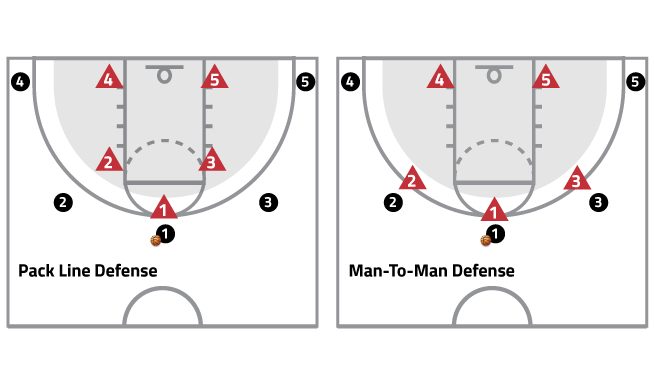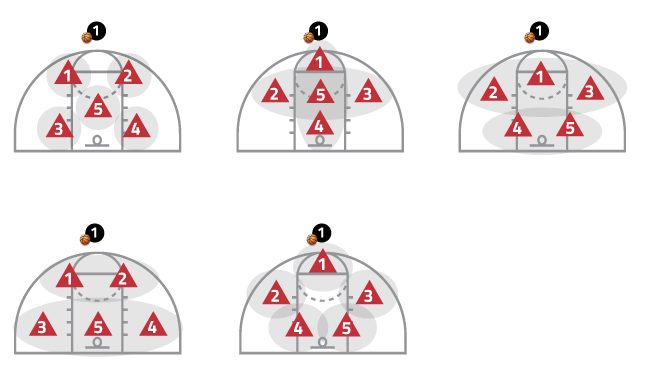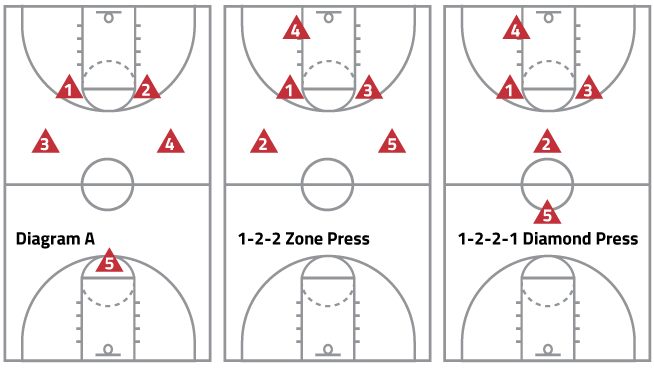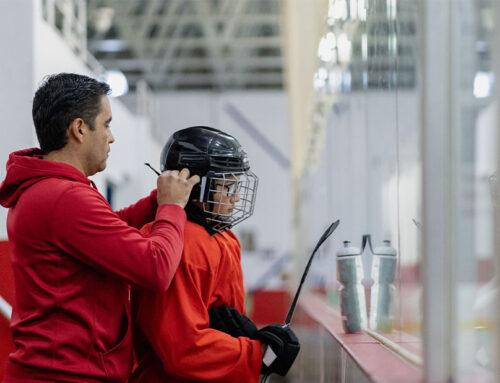Basic Defensive Plays for Youth Basketball Coaches
At any level of basketball, there are generally three types of defenses that can be played over the course of a game. In a half-court setting, your team can employ either a “Man-to-Man” or “Zone” defense, and in a full-court setting your team can use a Man-to-Man or Zone “Full-Court Press.”
While there are more complicated schemes within these structures that are used at higher levels of the sport, it is important for younger players to understand basic defensive concepts so they can develop and grow as players on the defensive end.
The following traditional defensive schemes are easy to teach and will help your players learn the three basic types of defenses.
Man-to-Man
The man-to-man defense is pretty self-explanatory—each player has to defend and follow the movements of another individual player.
- Traditional
- In the traditional man to man there are three positions in which you can be on the court.
- On Ball – If you are guarding the ball you will be in a defensive stance in front of your man trying to pressure or contain the ball.
- Denial – If your man is one pass away from the ball then you will be in a denial position, using your body and an extended arm to block the passing lane and prevent your man from getting the ball.
- Help – If your man is two or more passes away then you will be in a help position. You will be a few steps away from your man toward the ball or the ball side of the court, and ready to help defend a drive into the paint or recover to your man if they get the ball.
- In the traditional man to man there are three positions in which you can be on the court.
- Pack Line
- The pack line man-to-man defense puts more of an emphasis on protecting the middle and containing drives by eliminating the denial position.
- In the pack line you are either guarding the ball or in a help position. So if your man is one pass away from the ball, instead of denying them, you will be a step away from them in the gap between the ball and your man.
- The pack line defense is ideal for youth basketball because it simplifies defensive assignments and eliminates confusion about when you should be in a help position or denial position. It also emphasizes team defense because the concepts put less focus on the individual man you’re guarding and more about being ready to help other teammates and defend together.
Zone
In a zone defense each player has a spot in a specific formation and a corresponding area or zone for which they are accountable, and they must play on-ball defense if the ball enters their zone.
- Traditional
- In a standard zone the defenders move their position and responsible area on the floor in relation to where the ball moves, but the zone still generally retains its standard formation.
- Trapping
- In a trapping zone a team will designate areas in which the two closest players to the ball will run toward the ball and apply double-team pressure to create a turnover or disrupt the offense. Usually trapping zones will only trap in the baseline corners, and after the two players go to trap, the remaining three defenders will rotate to defend the closest offensive players to the ball by denying them.
- Types of Halfcourt Zones
- 2-3
- 3-2
- 1-3-1
- 2-1-2
- 1-2-2
Full-Court Press
A full-court press simply means that your defense applies pressure to the offensive team for the full length of the court, before and after the ball is passed inbounds. A full-court press is often applied to create turnovers, pressure or tire opponents, and slow down the pace of the game.
- Man
In a man-to-man press, the same traditional half-court principles are usually applied. However, when the ball is being taken out, the player guarding the in-bounder can pressure them or play off to help deny a pass or prepare to trap. Once the ball is inbounded the on ball defender will try to pressure the ball and get a steal or create a turnover.
-
- Trapping – a trapping man-to-man press will work by first designating when or where the team will trap. This will usually either be immediately when the ball is inbounded or when the ball is in a corner of the back court because the sidelines make it harder to escape a trap. When the trap occurs on the inbound pass the inbound defender will leave their man to trap with the current on ball defender. When the trap occurs in a corner, the closest two players to the ball will run to trap with the current on ball defender. In both of these cases the remaining three defenders will rotate to defend the next closest offensive players to the ball in hopes to ultimately create a turnover.
- Zone
A zone press will apply zone principles except there will generally be less on-ball pressure. A regular zone press will usually be used to slow the pace of the game by sitting back and playing a non-aggressive defense that slows the advancement of the ball up the court.
-
- Trapping – a trapping zone press will apply the same concepts as a trapping half-court zone. The traps will occur in the corners of the backcourt with the two nearest defenders trapping and the remaining three defenders rotating, but remaining mostly in their zone, to defend the next closest offensive players.
- Types of Full Court Zone Presses
- 1-2-1-1 “Diamond”
- 1-2-2
- 2-2-1
RELATED:
RECOMMENDED FOR YOU
MOST POPULAR
Basic Defensive Plays for Youth Basketball Coaches
At any level of basketball, there are generally three types of defenses that can be played over the course of a game. In a half-court setting, your team can employ either a “Man-to-Man” or “Zone” defense, and in a full-court setting your team can use a Man-to-Man or Zone “Full-Court Press.”
While there are more complicated schemes within these structures that are used at higher levels of the sport, it is important for younger players to understand basic defensive concepts so they can develop and grow as players on the defensive end.
The following traditional defensive schemes are easy to teach and will help your players learn the three basic types of defenses.
Man-to-Man
The man-to-man defense is pretty self-explanatory—each player has to defend and follow the movements of another individual player.
- Traditional
- In the traditional man to man there are three positions in which you can be on the court.
- On Ball – If you are guarding the ball you will be in a defensive stance in front of your man trying to pressure or contain the ball.
- Denial – If your man is one pass away from the ball then you will be in a denial position, using your body and an extended arm to block the passing lane and prevent your man from getting the ball.
- Help – If your man is two or more passes away then you will be in a help position. You will be a few steps away from your man toward the ball or the ball side of the court, and ready to help defend a drive into the paint or recover to your man if they get the ball.
- In the traditional man to man there are three positions in which you can be on the court.
- Pack Line
- The pack line man-to-man defense puts more of an emphasis on protecting the middle and containing drives by eliminating the denial position.
- In the pack line you are either guarding the ball or in a help position. So if your man is one pass away from the ball, instead of denying them, you will be a step away from them in the gap between the ball and your man.
- The pack line defense is ideal for youth basketball because it simplifies defensive assignments and eliminates confusion about when you should be in a help position or denial position. It also emphasizes team defense because the concepts put less focus on the individual man you’re guarding and more about being ready to help other teammates and defend together.
Zone
In a zone defense each player has a spot in a specific formation and a corresponding area or zone for which they are accountable, and they must play on-ball defense if the ball enters their zone.
- Traditional
- In a standard zone the defenders move their position and responsible area on the floor in relation to where the ball moves, but the zone still generally retains its standard formation.
- Trapping
- In a trapping zone a team will designate areas in which the two closest players to the ball will run toward the ball and apply double-team pressure to create a turnover or disrupt the offense. Usually trapping zones will only trap in the baseline corners, and after the two players go to trap, the remaining three defenders will rotate to defend the closest offensive players to the ball by denying them.
- Types of Halfcourt Zones
- 2-3
- 3-2
- 1-3-1
- 2-1-2
- 1-2-2
Full-Court Press
A full-court press simply means that your defense applies pressure to the offensive team for the full length of the court, before and after the ball is passed inbounds. A full-court press is often applied to create turnovers, pressure or tire opponents, and slow down the pace of the game.
- Man
In a man-to-man press, the same traditional half-court principles are usually applied. However, when the ball is being taken out, the player guarding the in-bounder can pressure them or play off to help deny a pass or prepare to trap. Once the ball is inbounded the on ball defender will try to pressure the ball and get a steal or create a turnover.
-
- Trapping – a trapping man-to-man press will work by first designating when or where the team will trap. This will usually either be immediately when the ball is inbounded or when the ball is in a corner of the back court because the sidelines make it harder to escape a trap. When the trap occurs on the inbound pass the inbound defender will leave their man to trap with the current on ball defender. When the trap occurs in a corner, the closest two players to the ball will run to trap with the current on ball defender. In both of these cases the remaining three defenders will rotate to defend the next closest offensive players to the ball in hopes to ultimately create a turnover.
- Zone
A zone press will apply zone principles except there will generally be less on-ball pressure. A regular zone press will usually be used to slow the pace of the game by sitting back and playing a non-aggressive defense that slows the advancement of the ball up the court.
-
- Trapping – a trapping zone press will apply the same concepts as a trapping half-court zone. The traps will occur in the corners of the backcourt with the two nearest defenders trapping and the remaining three defenders rotating, but remaining mostly in their zone, to defend the next closest offensive players.
- Types of Full Court Zone Presses
- 1-2-1-1 “Diamond”
- 1-2-2
- 2-2-1
RELATED:













